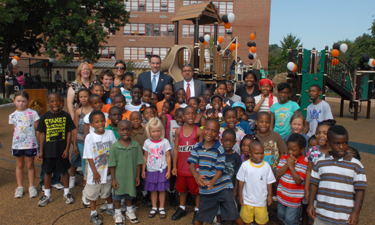 Mayor Vincent Gray of Washington, D.C., recently crafted an ambitious sustainability plan that will touch on almost all aspects of life for the District’s 632,000 residents, not to mention millions of commuters and visitors each year. A District native, Gray worked in nonprofit social service organizations before becoming director of the District’s Department of Human Services. He was elected to the City Council in 2004 and elected mayor in November 2010.
Mayor Vincent Gray of Washington, D.C., recently crafted an ambitious sustainability plan that will touch on almost all aspects of life for the District’s 632,000 residents, not to mention millions of commuters and visitors each year. A District native, Gray worked in nonprofit social service organizations before becoming director of the District’s Department of Human Services. He was elected to the City Council in 2004 and elected mayor in November 2010.
The Sustainable D.C. plan addresses four key challenges: creating jobs and growing the District’s economy; improving the health and wellness of residents; ensuring equity and diversity across the city; and addressing climate change and improving the environment. Key goals include cutting the obesity rate by 50 percent, reducing greenhouse gas emissions by 50 percent, having a park or natural space within a 10-minute walk of all residents, achieving 40 percent tree-canopy coverage, and adding 20 more acres of urban agriculture land to provide healthy, locally grown vegetables and fruit for residents.
In a city better known for its federal parkland, what do you see as the role of D.C.’s city parks?
While the federal parks in our city are integral to the District’s beauty and serve our residents and tourists alike, local parks and recreation centers also play an incredibly crucial role in enhancing the quality of life for District residents. They serve as neighborhood hubs and gathering spots and also play a central role in our city’s service-delivery system—including programs for children and seniors, athletic activities for individuals and groups, and educational activities for all residents.
How does parks and recreation fit into your Sustainable D.C. goals?
The Department of Parks and Recreation, and the facilities and programming it runs, will play an integral role in the implementation of our Sustainable D.C. plan. Whether the issue is childhood obesity or urban farming, our parks and recreation facilities have a tremendous impact on the health of our city. And the fact that DPR facilities and programming are offered in virtually every neighborhood in the District ties in clearly with Sustainable D.C.’s goals of equitability.
Why have you chosen to invest in renovating 32 playgrounds this year when there are so many other competing priorities?
I see our investment in playgrounds as an investment in the future of the District, because the number of children who live in our city is growing. Investing in playgrounds is one part of our continued work to improve our education system and our family programs. By making these investments, we not only give our children safe and pleasant places to play, but we also show them that we care about their development and well-being. This initiative is also critical as we redefine our play spaces to encourage all of our residents to get outdoors and moving. We’re designing and building innovative play spaces that are age-friendly to encourage intergenerational use, designed with our sustainability goals in mind, and focused on inclusiveness and accessibility.
Why are you such a strong supporter of D.C.’s park and recreation system?
My childhood in the District has definitely formed my view of our recreation spaces—after all, I grew up playing in many of the very spaces that we are now renovating. But I have also continued to use the facilities as an adult—most notably in a DPR softball league—and that also guides my work. As mayor and as someone who has worked for most of my career in advocacy for, and service delivery to, vulnerable populations in our city, I am keenly aware of the vital role that safe, attractive, and convenient park and recreation facilities can play in healthy development not only for youngsters, but also for adults.
We also asked Jesús Aguirre, director, D.C. Department of Parks and Recreation: In your role as director, how do you see the mayor supporting parks and recreation in the city?
Mayor Gray is keenly aware of the value that parks and recreation brings to the lives of our residents and visitors. He has a clear vision for building a truly sustainable Washington, D.C. In just one generation, the District of Columbia will be the healthiest, greenest, and most-livable city in the United States. This is bold and ambitious, and recognizes that the efforts of D.C. Parks and Recreation are crucial to its success. As an example, D.C. Parks and Recreation has the full support of the Mayor in ensuring that children have safe and exciting play spaces and residents have access to fresh food through urban-agriculture initiatives. Mayor Gray has been an unyielding supporter of our efforts as we work to improve the lives of District of Columbia residents and visitors by providing high-quality programming that is inclusive, accessible, and results driven.
Interview by Elizabeth Beard.
Washington, D.C., Mayor Vincent C. Gray
April 1, 2013, Department, by Elizabeth Beard

